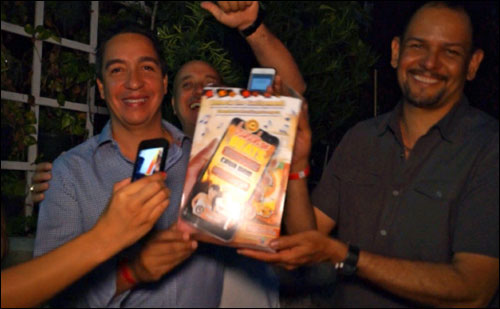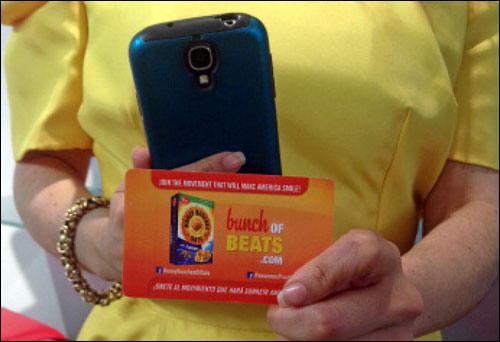Jun 18, 2014The breakfast cereal business is highly competitive, with annual U.S. sales topping $10 billion. Each year, food companies spend hundreds of millions of dollars on advertising. Post Foods, which makes GrapeNuts, Honey Bunches of Oats and 13 other brands, is always on the lookout for ways to engage directly with consumers, to boost awareness of its cereal products and cultivate customer loyalty. As part of its digital marketing strategy, the old-line company has embraced emerging technologies. "It's a very competitive space," says Michael Foley, Post Foods' senior brand manager. "You have to try to break through the clutter."
Last year, Post Foods decided to try using Near-Field Communication technology to connect with consumers and encourage them to interact with custom-developed, branded digital content. The company also wanted to see whether the data from the customer interactions would provide insight into consumer behavior and a way to measure the effectiveness of the campaign.

Post Foods tested the NFC solution at a concert in Miami, which the company was sponsoring under the banner of its popular Honey Bunches of Oats brand. It provided concertgoers with NFC-enabled cards that allowed them to access unique content, including downloadable songs, videos and a customer survey, using their own NFC-enabled smartphones. "We wanted to see what consumer acceptance would be," Foley says. "And we wanted to get out ahead of the curve."
More concertgoers than expected activated the cards and used their NFC phones to access the digital content. "NFC is truly an affordable and effective way to engage our consumers," Foley says. "It is now definitely part of our marketing toolkit."
A Controlled Environment
In 2013, Post Foods hired Camintel Group, a New York City-based startup that develops mobile applications for engagement marketing campaigns, to help develop the NFC solution. In a twist on traditional consumer advertising and outreach, engagement marketing seeks to actively involve individuals with a brand or product through social media or other means. It took just three weeks to design the solution.
Camintel provided the customized printed NFC tags and the cloud-based digital marketing platform, known as Touch2Like, which was optimized for mobile devices. XL Alliance, a cross-cultural marketing and strategy firm that works with Post Foods on digital and social-media campaigns, developed the content, which was hosted on Camitel's servers and could be updated or refined as needed.
Post Foods wanted to test the NFC marketing solution in a controlled environment, where attendance was limited and company representatives could be on hand to assist concertgoers who weren't familiar with their phones' NFC capabilities. The trial was integrated with another company marketing campaign—a Honey Bunches of Oats-branded national summer concert series known as El Tour Positivo (The Positive Tour), which targets Hispanic customers. The solution was introduced during a concert at Miami's Dolphin Mall, with the Venezuelan pop-duo Chino y Nacho, Latin Grammy winners, as headliners. Univision Radio, the leading Spanish radio network in the country, was a partner in the event.
At the El Tour Positivo event, "Bunchecitas"—brand ambassadors hired to interact with audience members—handed out boxes of Honey Bunches of Oats cereal to concertgoers, along with roughly 300 cards that bore the words "¡Descubre Más!" ("Discover More!"). Each card was embedded with a Smartrac BullsEye 13.56 MHz NFC tag made with an NXP Semiconductors' NT203 chip. Instructions were printed on the card, in both English and Spanish, explaining the four-step process needed to access specially developed content, including music, videos and a survey. As concertgoers entered the venue, the Bunchecitas demonstrated how to tap the phones on the NFC cards to access the custom content. The phone's NFC reader captured the card's unique identification number and accessed a webpage associated with the Tour Positivo concert. Attendees also could access the material by typing in a QR code or URL.

An Engaged Audience
The Chino y Nacho audience, which was predominantly Spanish-speaking, was well-suited for the NFC project, Foley says, since Hispanic consumers are more likely to use Android and other smartphones with NFC capabilities than other groups. Apple iPhones do not come with NFC capability, although there is widespread industry speculation that will change with the next version of the phone.
Introducing the NFC project was a relatively simple process, Foley says. Camintel tested all the NFC cards before they were distributed, and there were no performance problems. The only challenge was the audience members' unfamiliarity with activating or using NFC features in their phones. But with assistance from the Bunchecitas, most people quickly learned how to activate the NFC features, he says.
Post Foods reports that 22 percent of the cards were activated—the majority via NFC devices, which exceeded Foley's expectations. Four percent of concertgoers used a QR code to access the custom content, and 4 percent typed a URL into their phone's browser. To his surprise, some people went back days or even weeks after the concert to access the content via the NFC card.
What kind of content was of most interest to consumers? The performing artists' music and videos, rather than Post's branded content and survey.
After the event, Camintel provided Post Foods with reports on how the campaign's content was accessed and viewed via its measurement software, Celerity Insight. With those reports, Post gained visibility into the NFC project, seeing what types of devices consumers used to access the online content and how much time was spent viewing the different types of content. In addition, Post was able to collect zip codes and IP addresses for targeted advertising. "It was an efficient way of collecting [consumer] data," Foley says.
Based on these results, Post Foods is incorporating NFC applications into its marketing efforts at as many as eight events this year. The company plans to distribute roughly 3,000 NFC cards to consumers and bloggers at concerts and other events, Foley says.
Post Foods also plans to expand its use of NFC technology for marketing. Foley expects NFC will be used to deliver tailored, consumer messaging, including updates on products or events, news about artists affiliated with the cereal brands, targeted coupons and more. The company says it will target both Hispanic and non-Hispanic audiences and different age groups. "This is a great way to go about brand management surgically," Foley says.
A benefit of using Camintel's cloud-based platform is that the content residing on the servers can be tweaked or updated for different events, Foley says, while the same version of the NFC card can be used at multiple events. Each card costs $1, and by eliminating the expense of reprinting, he says, it's an "extremely effective" solution. He envisions using the cards for tap-and-pay scenarios, to purchase Post brands online or at a local grocery store.
Foley believes using emerging technology to market an established product is a recipe for success. "It is really refreshing for consumers," he says. "We believe this is an excellent example of an established brand working with an emerging technology to provide a rewarding customer experience."
